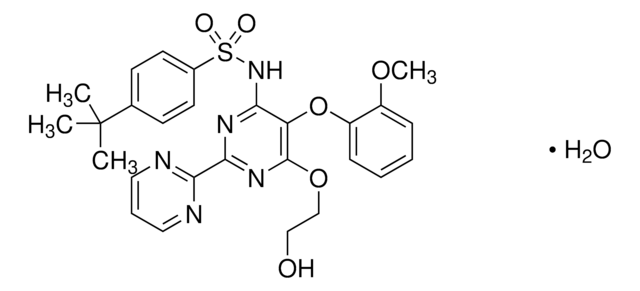SCP0134
Endothelin Antagonist PD 142893
Se connecterpour consulter vos tarifs contractuels et ceux de votre entreprise/organisme
About This Item
Formule empirique (notation de Hill):
C50H65N7O10
Poids moléculaire :
924.09
Code UNSPSC :
12352200
Nomenclature NACRES :
NA.32
Produits recommandés
Pureté
≥95% (HPLC)
Forme
lyophilized
Composition
Peptide Content, ≥85%
Conditions de stockage
protect from light
Température de stockage
−20°C
Amino Acid Sequence
Acl-Dif-Leu-Asp-Ile-Ile-Trp
Application
PD 142-893 is used as a nonselective endothelin ET(A)/ET(B) receptor antagonist.
Code de la classe de stockage
11 - Combustible Solids
Classe de danger pour l'eau (WGK)
WGK 3
Point d'éclair (°F)
Not applicable
Point d'éclair (°C)
Not applicable
Certificats d'analyse (COA)
Recherchez un Certificats d'analyse (COA) en saisissant le numéro de lot du produit. Les numéros de lot figurent sur l'étiquette du produit après les mots "Lot" ou "Batch".
Déjà en possession de ce produit ?
Retrouvez la documentation relative aux produits que vous avez récemment achetés dans la Bibliothèque de documents.
Ashley M Stokes et al.
Canadian journal of veterinary research = Revue canadienne de recherche veterinaire, 70(3), 197-205 (2006-07-21)
The goals of this study were to determine the concentration-response (C-R) relationship of endothelin-1 (ET-1), compare 2 ET-receptor antagonists and determine the antagonist concentrations that block the vasomotor effects of ET-1, and compare the effectiveness of ET-1 and previously studied
Chumpon Wilasrusmee et al.
Surgery, 134(2), 384-389 (2003-08-30)
We have previously shown that endothelial injury by cyclosporin A (CyA) is associated with an increased endothelin-1 (ET-1) release. We now sought to determine, in an animal model of angiogenesis, if inhibiting the effect of ET-1 on endothelial cells (ECs)
Sebastien Faure et al.
Journal of vascular research, 43(1), 19-26 (2005-10-29)
The effect of angiotensin IV (AngIV) was studied in freshly isolated rat basilar arteries (BAs) perfused at a constant rate. AngIV had no effect on basal BA perfusion pressure, but induced a marked concentration-dependent contraction in vessels precontracted by a
Alexandra Madsen et al.
Journal of molecular and cellular cardiology, 154, 115-123 (2021-02-15)
The role of DNA methylation in cardiomyocyte physiology and cardiac disease remains a matter of controversy. We have recently provided evidence for an important role of DNMT3A in human cardiomyocyte cell homeostasis and metabolism, using engineered heart tissue (EHT) generated
Notre équipe de scientifiques dispose d'une expérience dans tous les secteurs de la recherche, notamment en sciences de la vie, science des matériaux, synthèse chimique, chromatographie, analyse et dans de nombreux autres domaines..
Contacter notre Service technique






